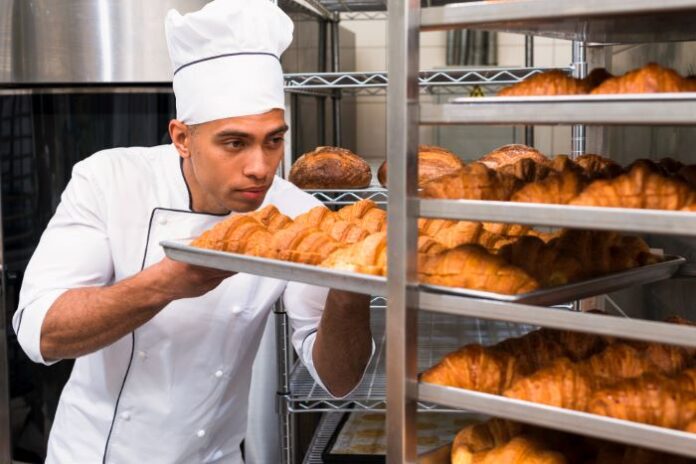When it comes to enjoying our favorite treats, especially those delicious ready-to-eat pastries we all love, safety is as important as taste.
Have you ever wondered how those pastries are handled before they make it to your plate? That’s the reason for such a question as ‘What should food workers use to handle ready-to-eat pastries?’
So, in this article, we will take a closer look at all of this, showing what the recommended method for handling such a food is, and why it is the best practice. Curious to know what should food workers use to handle ready-to-eat pastries? Just keep reading!
What Should Food Workers Use to Handle Ready-to-eat Pastries
- Deli tissue
- Clean hands
- Cloth gloves
- A single-use apron
The answer here is option A. Deli tissue. Yes, Food workers should use deli tissue to handle ready-to-eat pastries. Now, let’s explain why that is the correct answer.
Explanation
The reason food workers should use deli tissue to handle ready-to-eat pastries is because deli tissue, or any similar type of food-safe disposable paper or barrier, is designed to prevent direct contact between the food handler’s hands and the food.
This reduces the risk of contamination from pathogens or other contaminants that might be on the hands, even if they are clean.
Ready-to-eat foods, such as pastries, do not undergo any further cooking or preparation steps that could eliminate pathogens, so it’s crucial to minimize the risk of contamination at this stage. So, what about the other options?
- Clean hands are essential for food safety, but even washed hands can carry residual bacteria or viruses. Direct contact with ready-to-eat food should still be avoided when possible. That is why option B is not the most accurate answer to the question, ‘What should food workers use to handle ready-to-eat pastries?’
- Cloth gloves can harbor bacteria and other pathogens if not cleaned and sanitized properly between uses. They are also not as effective as single-use barriers because the risk of cross-contamination is higher.
- A single-use apron is primarily for the protection of the worker’s clothes from food spills and does not serve as a barrier between the food and the handler’s hands.
So, you can now see that reason deli tissue or a similar disposable barrier when handling ready-to-eat foods is a best practice in food safety. It helps to ensure that food remains safe for consumption by preventing the introduction of potential contaminants.
Now that we have the answer to the question, ‘What should food workers use to handle ready-to-eat pastries?’ let’s take a closer look at the subject for a more comprehensive understanding.
What Are Some Examples of Ready-to-Eat Pastries?
Ready-to-eat pastries are a broad category of food that includes any baked goods that can be consumed without the need for further cooking or preparation.
This delightful group encompasses a wide variety of treats that are often the centerpiece of our morning routines, special occasions, or that sweet spot in our afternoon snack time.
Examples include croissants, muffins, doughnuts, Danish pastries, and slices of pie or cake. Each of these items is prepared, baked, and presented in a way that allows you to enjoy them immediately after purchase or delivery, offering convenience and satisfaction in every bite.
When Should You Wear Gloves In The Kitchen?
Wearing gloves in the kitchen is key for maintaining food safety, but they’re not needed for every task. Here’s when they’re most important:
- When handling raw meats to prevent cross-contamination
- When preparing food for people with allergies to avoid allergen transfer
- If you have any cuts or sores on your hands to protect the food.
Also, for ready-to-eat items like pastries, using gloves (or other barriers) helps keep them safe from direct hand contact.
However, you should remember that gloves don’t replace good handwashing. Always wash hands before wearing gloves and change them regularly to avoid contamination. This simple practice is crucial for keeping both the kitchen and the food safe.
Some Essential Ways to Prevent Cross-Contamination in the Kitchen
Preventing cross-contamination in the kitchen is fundamental to ensuring food safety. So, let’s take a quick look at some essential practices that can help.
Separate Raw and Cooked Foods: Always keep raw meats, poultry, and seafood separate from ready-to-eat foods. Use separate cutting boards, utensils, and plates for raw and cooked foods to avoid transferring harmful bacteria from raw foods to those that are ready to eat.
Use Color-Coded Equipment: Implementing a color-coded system for cutting boards and utensils can help prevent cross-contamination. For example, use one color for raw meats and another for vegetables.
Proper Storage: Store raw meat, poultry, and seafood on the bottom shelf of the refrigerator to prevent their juices from dripping onto other foods.
Wash Hands and Surfaces Often: Regular handwashing and sanitizing of kitchen surfaces and equipment after each use are crucial to eliminate pathogens that can cause foodborne illnesses.
Cook Foods to Safe Temperatures: Cooking foods to the right temperature can kill harmful bacteria. Use a food thermometer to ensure meats are cooked thoroughly.
Is it OK to Use the Same Gloves Every Single Time?
No, it’s not recommended to use the same gloves for every task in the kitchen. Reusing gloves without changing them between different tasks can lead to cross-contamination, spreading bacteria and other pathogens from one food item to another.
Gloves are designed to be a single-use barrier to protect food from contamination. Once gloves have been used for handling a specific food item, especially raw meats, poultry, seafood, or allergenic ingredients, they should be discarded and replaced with a new pair before touching another food item or surface.
It’s essential to change gloves:
- After handling raw foods to prevent spreading bacteria to ready-to-eat foods.
- After performing non-food related activities, like handling trash, using the phone, or touching your face or hair.
- When moving from preparing allergen-containing foods to allergen-free foods to prevent triggering food allergies.
What is the Correct Order for Cleaning Food Contact Surfaces?
Before we round up this post about ‘What should food workers use to handle ready-to-eat pastries?’ let’s take a look at the 4-step approach for cleaning food contact surfaces.
Cleaning these surfaces correctly is important for preventing foodborne illnesses. So, let’s see the correct order to follow:
#1: Wash
First, remove any food particles or debris from the surface using hot, soapy water. This step is essential for removing the majority of the soil, making the sanitizing process more effective.
#2: Rinse
After washing, rinse the surface with clean water. This step removes any remaining soap residue and loosened dirt, preparing the surface for sanitization.
#3: Sanitize
Use a sanitizing solution to kill any remaining bacteria, viruses, and other microorganisms. Follow the manufacturer’s instructions for the correct concentration and contact time required for the sanitizer to be effective.
#4: Air Dry
Finally, allow the surface to air dry completely. Drying with a towel can reintroduce bacteria to the surface, so air drying is the recommended method to ensure the sanitizing process remains effective.
What Should Food Workers Use to Handle Ready-to-eat Pastries – Final Note
To bring this to a close, you should remember that the safest practice for food workers handling ready-to-eat pastries is to use deli tissue or a similar barrier to prevent direct contact and minimize the risk of contamination.
We have also taken the time to explain the importance of maintaining food safety through proper handling practices, including the use of gloves for certain tasks and the correct cleaning of food contact surfaces. If you missed any of these, just scroll up to catch the full gist.
If you have any more concerns or questions concerning this, we encourage you to leave a comment for us in the section below. We will be glad to help!
Related Articles You Might Like:








